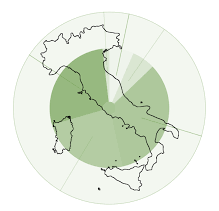What is the Italian GDB initiative
Collaborators
Research Institutes
What is the Italian GBD Initiative?
The Italian Global Burden of Disease Initiative, or Italian GBD Initiative, is an Italian network of researchers actively contributing to the project Global Burden of Disease Study, GBD.
To date, more than 175 collaborators from more than 25 research institutions are part of the Italian GBD Initiative.
What is GBD?
Goals of the Italian GBD Initiative
The main goal of the Italian GBD Initiative is to coordinate the effort made by Italian collaborators in order to improve Italian and global GBD estimates.
The researchers shared the need to coordinate to meet a number of objectives:
- share experiences, to strengthen and coordinate the exchange with the IHME;
- disseminate the estimates generated by GBD, and support their use as design tools in Italy, looking at the experiences of other countries;
- Strengthen data and information sharing with IHME in order to generate increasingle better estimates;
- in agreement with IHME, undertake the process of generating regional estimates for Italy (for 19 Regions and two Autonomous Provinces), thus enabling analysis of geographic inequalities and reflecting on economic and social inequalities.
Brief history of the Italian GBD Initiative
The first Italian collaborators were involved in the GBD in 2007/2008, dealing with global estimates of chronic kidney disease (Mario Negri Institute, Bergamo) and otitis media (Burlo Garofolo Institute, Trieste).
In 2015, in Evia, Greece, during the GBD Technical Workshop, the possibility of bringing together Italian GBD collaborators, 15 at the time, into a network was discussed.
In October 2016, convinced of the potential of GBD as an excellent public health research, planning and prevention tool, the first meeting of the Italian collaborators was held in Venice. Hosted by Prof. Giancarlo Logroscino and the XLVII Congress of the Italian Society of Neurology.
In November 2018, the IHME approved the Italian GBD Initiative’s request to develop regional estimates for Italy.
In January 2020, a two-day workshop was organized at La Sapienza University in Rome to analyze and revise the Italian GBD 2019 regional estimates.
Official subnational estimates will be officially published with the release of GBD 2021.
The founders of the Italian GBD Initiative
The network was born in 2016 on the initiative of Lorenzo Monasta and due to the strong will and participation of the co-founders:
Lorenzo Monasta and Luca Ronfani (IRCCS Institute for Maternal and Child Health “Burlo Garofolo,” Trieste)
Giancarlo Logroscino (Department of Basic Medical Sciences, Neuroscience and Sense Organs of the University of Bari “Aldo Moro” and Center for Neurodegenerative Diseases of the Ecclesiastical Body Pia Fondazione di Culto e Religione “Card. G. Panico,” Tricase)
Giuseppe Remuzzi, Ettore Beghi, Norberto Perico and Boris Bikbov (IRCCS – Mario Negri Institute for Pharmacological Research, Milan and Bergamo)
Miriam Levi and Alberto Baldasseroni (Azienda USL Toscana Centro, Florence)
Luigi Naldi (GISED Study Center, Bergamo)
Massimo Cirillo (University of Salerno, now Department of Public Health, University of Naples Federico II)
Francesco Saverio Violante (Department of Medical and Surgical Sciences, University of Bologna)
Stefano Ricci (UO Neurology USL Umbria 1, Città di Castello)
GBD is a useful project for Italy, but complex
The Italian researchers involved contribute to various aspects.
There are experts from specific clinical and epidemiological areas, and from specific geographic areas – Europe, Italy, individual regions. They are familiar with Italian data, sources, studies, and thus contribute significantly to improving both estimates for Italy and global estimates.
In addition, Italy is rich in good-quality socio-health data that can feed into estimation models, not only for Italy. Italy provides less data than only the United States, the United Kingdom, China, and India.
The thematic groups
Given the complexity of the tasks required to be able to contribute meaningfully, and as the group has grown from about 10 researchers in 2016 to more than 175 to date, researchers in the Italian GBD Initiative have decided to work in thematic groups that can address specific issues, such as estimates on cancer, or those on cardiovascular disease, or even environmental or behavioral risk factors. To date, we work in 20 groups.
